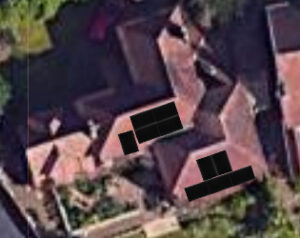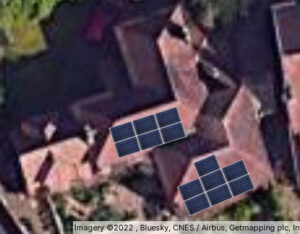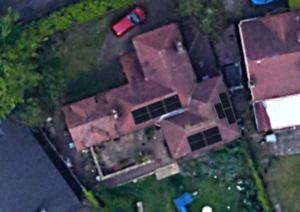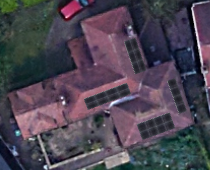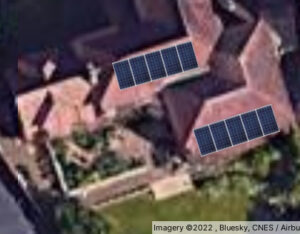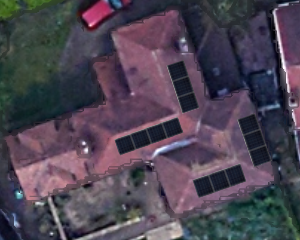This page contains our notes about our proposed solar PV installation.
“A little knowledge is a dangerous thing”, so the saying goes. I am no expert on these matters, just technically savvy and curious to learn and understand it all. I’m hot on electrics, physics, geometry, calculation; but weak on the practicalities in this industry. That’s why we’re approaching installers for their expertise in design and installation. Not everything here may be correct or make sense.
I am learning as I go along, starting in November 2022.
Contents:
- Outstanding Concerns, Requests, Questions
- Our Household Energy Usage
- Our own roof measurements
- Our own system planning exploration
- Panel Layouts Suggested by Installers
- Inverter
- Panels
- Shading
- Battery
- Installation requests
- Control and Monitoring
Removed from scope:
Air Source Heat Pump (ASHP) System[removed from scope]Other household energy system changes
Outstanding Concerns, Requests, Questions
Solar PV:
- Advice: Should we maximise system size and generation, at the cost of complexity (multiple orientations, shading, MPPT inputs)?
- Advice: Our roof has an awkward L-shaped valley, dividing it into four or five small usable areas. Some areas suffer shading from the roof valley shape. Unsure of the impacts (shading factor, panel-level optimisers, multiple MPPT inputs).
Inverter:
- To best integrate with on-site home automation, select Fronius, and in particular Fronius GEN24 Plus. (Open question on OpenEnergyMonitor community: Should we choose a Fronius inverter for best cloud-free PV monitoring interfaces?)
- Fronius Inverter: can we add the “full backup” option at small extra cost? (Because, “why not?”)
- Inverter sizing: stick to 3.6 kW for certification simplicity, or go bigger for better yield?
Battery:
- Battery sizing: what is optimum battery size for us? (Can we see the calculations?)
- Compatibility: Fronius says only BYD and one other battery are compatible, but these are expensive; a local installer told us that “LG Chem” is also compatible, and much cheaper. What’s the case, what are the nuances?
General
- Question: who underwrites the long guarantees (10 years to 25 years), given that many companies go out of business in this time frame? (I’m told SunSynk said they have an arrangement for their guarantee to be covered by another party in that case.)
Our Household Energy Usage
Expected energy usage, per year:
Electricity: ~5,000 kWh
Gas: ~16,000 kWh
Energy usage history: see Our Energy Consumption
Our own roof measurements
- 4 or 5 potentially useful roof surfaces (see diagrams below)
- 2 larger roofs facing roughly south:
- roof pitch: 45°
- roof azimuth: 20° east of south / compass bearing 160° / -20° from south
- roof height: 3.0 m gutter-to-ridge
- 2 smaller roofs facing roughly east:
- roof pitch: 45°
- roof azimuth: 20° north of east / compass bearing 070° / -110° from south
- roof height: 3.0 m gutter-to-ridge
- 1 smaller roof facing roughly west:
- roof pitch: 45°
- roof azimuth: 20° south of west / compass bearing 250° / +70° from south
- roof height: 3.0 m gutter-to-ridge
(roof section heights, all cases: counted 27~30 tile rows; best estimation is 3.0 m gutter-to-ridge)
Our own system planning exploration
Reminder: I’m new to this. This is experimental. These plans are ideas for discussion, not final.
We have no preference for make/model/type/colour of panels.
Planning attempts:
- Easy PV Project Report – Julian’s version 1
- This version of our plan shows a 6 kW inverter where 5 kW is probably enough; likewise other details may be inappropriate.
- No shading is defined for any panels in this version. Two roofs are behind a valley: the lower those panels reach, the more shading they have.
- This layout pattern uses panels of the most elongated shape I could find (1855 x 1029 mm), in landscape orientation, just to illustrate one of the extremes of shape and layout that might fit. More common panel sizes are ~1100×1700 mm.
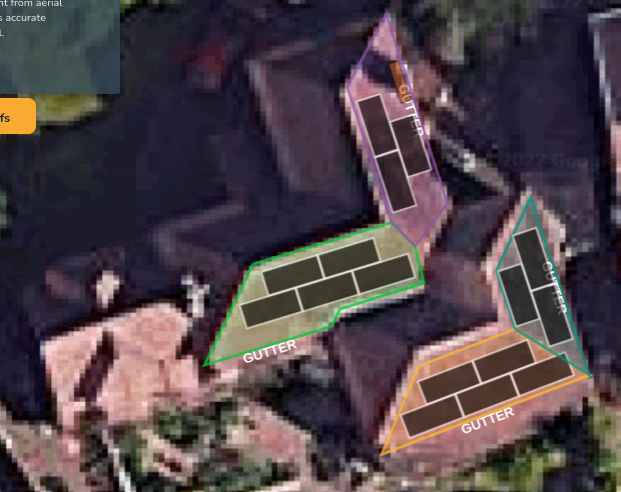
Looks like 16 panels may be too much of a squeeze.
- This version of our plan uses panels of more common shape and a more conservative fit in the available space.
- 12 panels shown: 4 and 3 on SSE roofs, 3 and 2 on ENE roofs
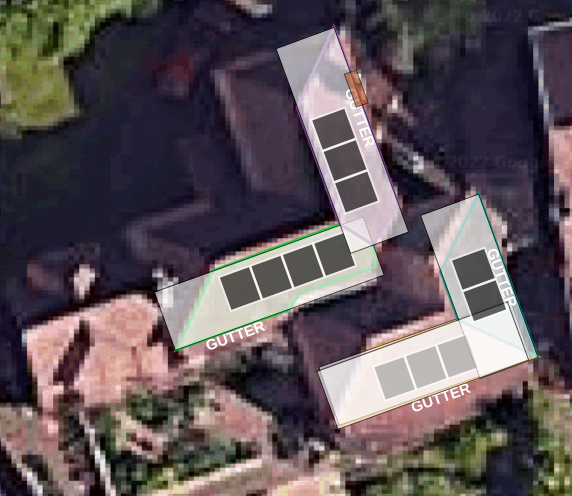
We’re also looking to add more (2) panels on the west-facing roof space.
Panel Layouts Suggested by Installers
Inverter
Aims:
- Home automation connection, locally: the power monitoring should be independent of anyone’s “cloud” service. Including any “apps”, and any available control functions.
- Backup capability? Ability to run the house from battery and/or solar power alone, when the grid has a power cut.
Backup capability:
- See for example https://www.spiritenergy.co.uk/kb-solar-panel-backup (compares DC-Coupled (SolaX) and AC-Coupled (Tesla Powerwall 2))
- Ability to operate in “island mode” always requires a G98/G99 certificate (and not G99 fast track applications)
- Manual or automatic switch-over? Automatic is obviously nice, but not too important.
- Whole house or split? Probably whole house: we can add a smart switch per device if desired, any time later, easily for appliances up to 13A. Perhaps split and don’t back up any too-high-power circuits such as electric shower; alternatively we can just avoid using it.
Tech specs relevant to solar inverters:
- Communication protocol: (standard) SunSpec Modbus protocol IEEE-1547 (explanation), (optional) manufacturer’s other open protocol such as Fronius API (JSON).
- Communication physical connection: any of Ethernet, WiFi, Zigbee, perhaps other.
Research:
- Fronius seem to be the only inverter manufacturer that makes known a serious commitment to local API with open protocols: Fronius Solar API info.
- Home Assistant (preferred open home automation system) has good integration for Fronius inverters.
- SolarEdge looks like the second best make in this regard: local connection available through hard-wired ethernet (previously also wifi but that no longer enabled in recent versions).
- Home Assistant has some integration for local connection to SolarEdge and a few others; but neither SolarEdge nor others seem to promote or prioritise this from their end.
Choice:
- Fronius Primo GEN24 Plus (3 to 6 kW) (page for installers | page for home owners)
- sizing: 3.6 kW (~2% loss), 4.0 kW (~1% loss), 4.6 kW (~0% loss) (assuming system 5 kWp)
- with “full backup” add-on, because “why not?”: small additional cost for grid outage backup.
Some suppliers of Fronius Primo GEN24 Plus (just from a general DuckDuckGo search):
- Wind & Sun Ltd. ~£2000, +44 (0)1568 720364, sales@windandsun.co.uk
- Bimble Solar ~£2000, +44(0)1273 931110, info@bimblesolar.com
- SolarAnna Ltd. (ZEROhomebills.com) ~£1800, +44 (0)333 7720526,
Assigning strings of panels to Inverter MPPT Inputs
A principle often repeated is each group of panels facing a different direction, or with different shading, should go to a separate inverter input. Maximum power will not be achieved otherwise. However, the power loss from ignoring this principle might be small.
There are 4 main roof areas, two roughly south facing (-20° from south), two roughly east facing (-110° from south), plus potentially one small roughly west facing area (+70° from south). Two roof areas are at the back of a roof valley and so have some shading at times of low sun elevation.
Some inverters have 1 MPPT input, some have 2 MPPT inputs (including Fronius Primo GEN24 Plus).
How many separate MPPT inputs do we need to connect, in order to capture a reasonable fraction of maximum available power?
Panels
Aim: maximise capacity, for the sake of future use and economy of scale.
Requirements:
- No particular requirements on size, make, style, colour.
Research:
- See my plan (shown above) made on Easy-PV
- Consider whether 16 panels can fit.
- Consider panels of more elongated shape (~1850 x 1050 mm) instead of the more common shape (~1700 x 1100 mm) if that helps.
- Considered triangular panels: they seem to be expensive and hard to obtain (few suppliers).
- Lichen growth, especially on non-south-facing panels. Are some panel types more resistant than others? Concern because ours are quite high and difficult for cleaners to reach.
Shading
I estimated our shading factors, with assistance from easy-pv.
- rear south-facing roof: around 0.6 to 0.75
- rear east-facing roof: Around 0.8 to 0.9
Panel Level Optimisation (PLO) or Module Level Power Electronics (MLPE):
One line of wisdom says we need PLO/MLPE: either a micro-inverter or a DC conditioning unit on each panel.
Another line seems to show this doesn’t in fact help, when compared with a good PPT string inverter.
- “Use MLPE if shading is present”, a take-away from Nova Solar’s article on Solar System Shading
- “No difference between good MLPE () and good string inverter (Fronius)”, from NRG’s article
Battery
- Battery sizing. Still TBC whether we install PV + ASHP together or PV first and ASHP later. Consider probably sizing for PV + ASHP. (Is that the conditions where a smaller battery is appropriate?)
- Battery (system) type: what’s compatible with Fronius inverters? See Fronius Compatible Batteries — looks like it requires BYD Battery-Box Premium HVS/HVM
Installation requests
- Battery and inverter in under-stair cupboard next to existing electric supply consumer unit.
Control and Monitoring
Open source home automation system:
- Home Assistant: see my article A Freedom-Respecting Smart Home
- Home Assistant’s page on Home Energy Management
- OpenEnergyMonitor project; their shop; their EmonCMS which can be self-hostd
Solar PV monitoring:
Heat pump monitoring:
- Lots of info on John Cantor Heat Pumps site https://heatpumps.co.uk/: start at Energy Monitoring page
- OpenEnergyMonitor’s heat pump docs
